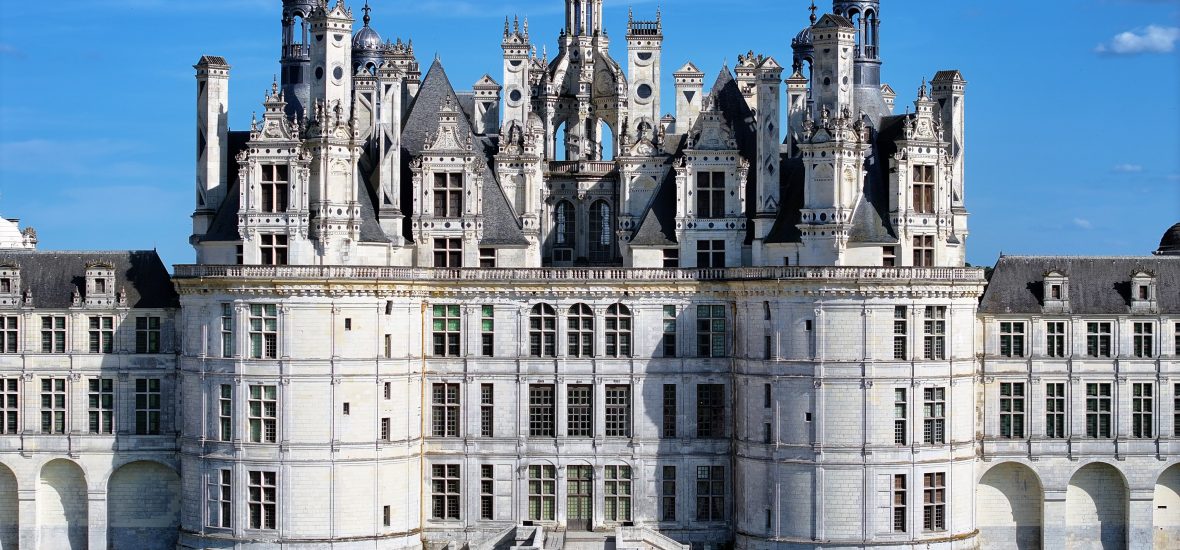Launched in 2021 and completed in June 2023, the restoration of the Château’s six roof lanterns, supervised by François Chatillon, Chief Architect of Historic Monuments since 2004, was carried out as part of a single project. Aside from occasional repairs, no restoration work had been performed on the lanterns for more than 50 years.
Reinforcement and protection of framework
The need to protect the framework had become urgent, at the risk of it being undermined by water seepage and stability issues. Scaffolding was initially installed to remove the slate and lead roofing from the lanterns and examine their state of health. Three of the six roof lanterns were found to have structural support problems and many defects in their waterproofing. The work that was done on them involved repairing skeletal flaws, namely including repairs to the framing, incorrectly assembled parts, the straightening and reinforcement of centrepieces and the braces needed for their structural integrity, the replacement of excessively damaged wooden parts and correction of the waterproofing of the lead and slate roofing.
Re-establishment of decorative unity
An analysis of changes in Chambord’s roofing revealed a series of several decorative looks featuring imposing finials at the top and ornamentation at the base of each dome, in stylistic unity with the stone decorations on the Lantern Tower and at the corners. The look before this project was relatively bare compared to the profusely intricate stonework of the upper sections, which disrupted the monument’s decorative unity. This was the result of the “minimalist” aesthetic choice that was in favour in 1950 when the roofing was rebuilt on the Henri V corner. After being destroyed by a fire in 1945, it was reconstructed in the very understated style of the first half of the 19th century. The François I and Caroline of Berry lanterns were restored next, following the same model of removing the ornamentation that had been put in place in the late 19th century, creating a divergence with the stone decorations. The National Heritage and Architecture Commission, based on a report from the Ministry of Culture, approved
the recreation of the old lead decorations – fleurs de lys, salamanders and candlesticks – and the gilding on the weathervanes in their last known state (from the second half of the 19th century).
Contractors and trades
Like an open-air laboratory, the restoration of Chambord’s roof lanterns involved a variety of fantastic tradespeople who skilfully met the challenge of preserving an assortment of ancient materials like wood, lead and slate. Three companies in the Centre-Val de Loire region worked on this project: Guèble (a member of the Villemain Group), which put up the scaffolding, and Battais-Centre and Ateliers Perrault, which restored the framework. The ornamentation work was carried out by Loire Ornements, whose workshop is located in the Maine-et-Loire department. Assisted by Couvertures de Loire, they reworked and recreated all the lead decorations.
A certified “Living Heritage Company”, Atelier Mariotti gilded the lanterns’ weathervanes, while Atelier Tollis worked on the colours for the leaden domes. The roofing was restored by “groupe UTB”. Two of the lanterns have slate roofing ( Chapel Tower and Robert of Parma Tower), while the four on top of the keep feature lead roofing ( Dieudonné, François I, Henri V and Caroline of Berry Towers).

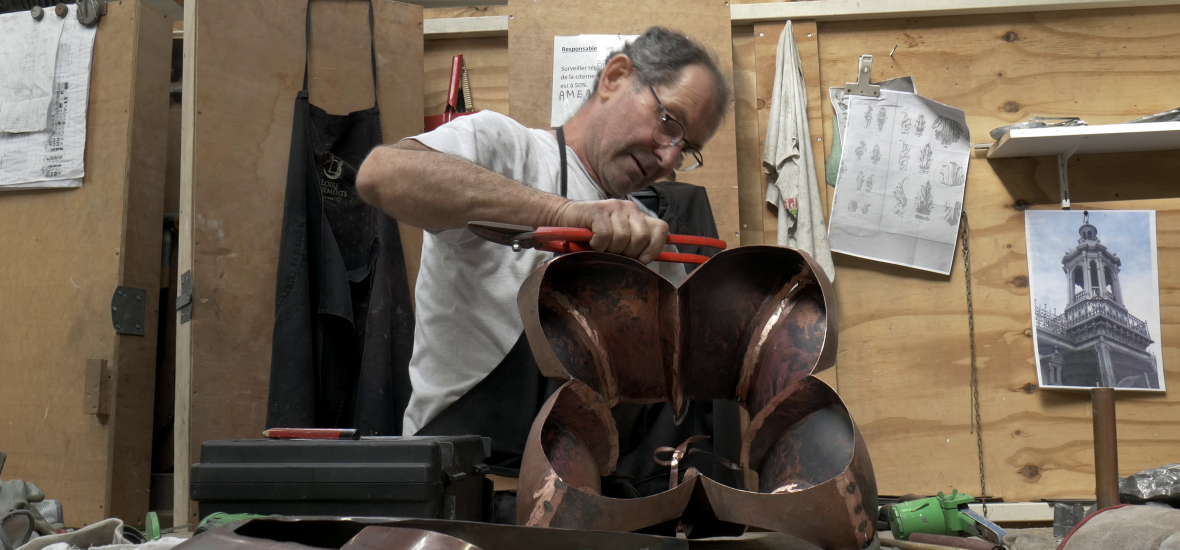
– 6 restored lanterns (the four made of lead on the keep and two made of slate)
– 12 metres in height with the weathervane (10.3 m without)
– 15 tonnes (weight of one roof lantern)
– 80 tonnes of scaffolding rising 54 metres in the air
– 30 people working on the project
– Nearly €4 million spent on this restoration project
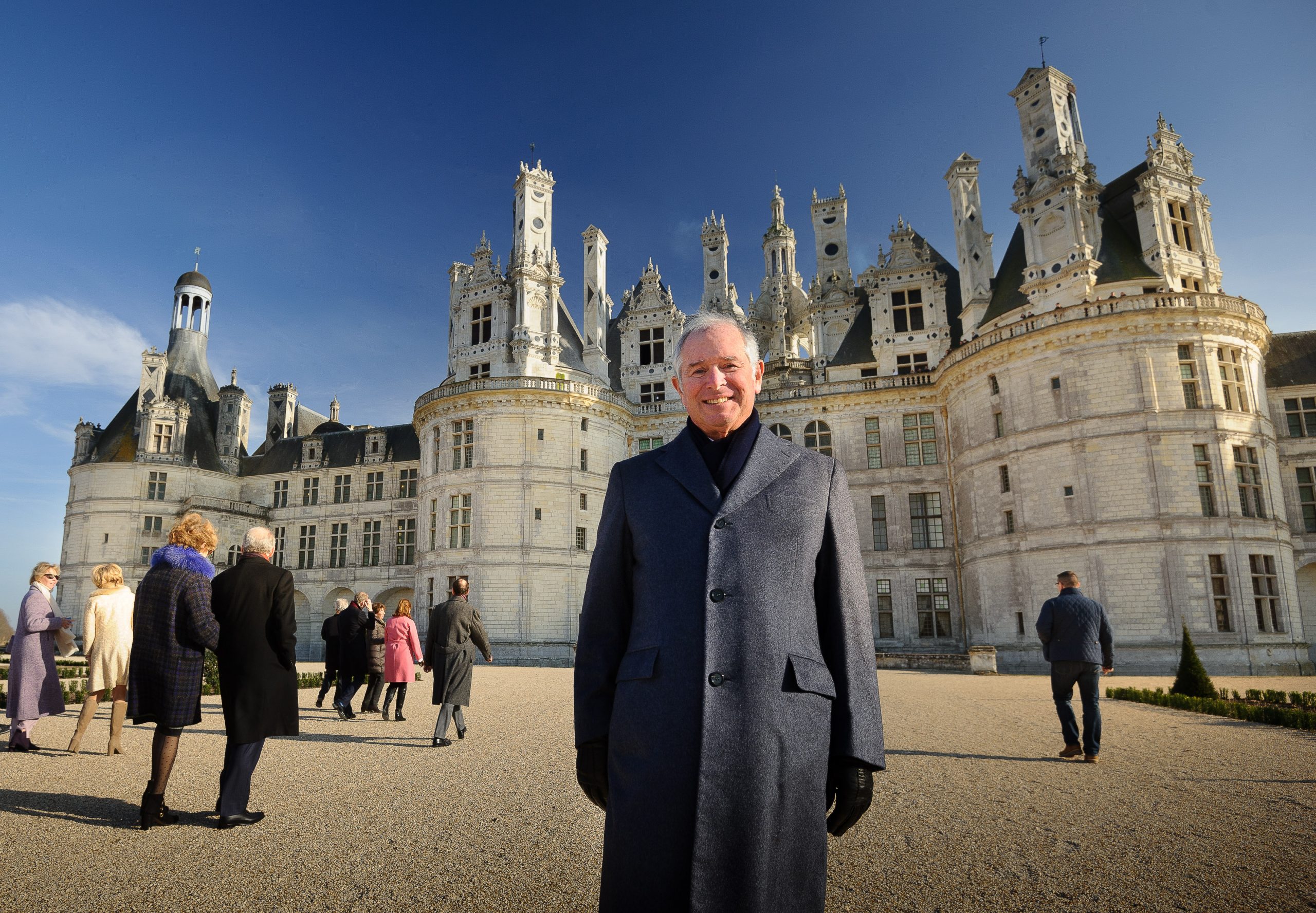 Domaine national de Chambord extends its thanks to Stephen A. Schwarzman, a major donor to Chambord, for his ongoing support. After making a donation in 2017 to finance the recreation of the Château’s formal gardens, Mr. Schwarzman continues to share his passion for Domaine national de Chambord. “Chambord is a national treasure, with significant importance to the cultural heritage of France, the French people as well as the international community. I’m proud to provide additional support for this restoration to ensure future generations can enjoy and learn from all that Chambord has to offer.
Domaine national de Chambord extends its thanks to Stephen A. Schwarzman, a major donor to Chambord, for his ongoing support. After making a donation in 2017 to finance the recreation of the Château’s formal gardens, Mr. Schwarzman continues to share his passion for Domaine national de Chambord. “Chambord is a national treasure, with significant importance to the cultural heritage of France, the French people as well as the international community. I’m proud to provide additional support for this restoration to ensure future generations can enjoy and learn from all that Chambord has to offer.
Biography of Stephen A. Schwarzman
Mr. Schwarzman is Chairman, CEO and Co-Founder of Blackstone, one of the world’s leading investment firms with $1 trillion in AUM (as of June 30, 2023) and businesses in private equity, real estate, hedge funds, credit, infrastructure and life sciences.
 In both business and philanthropy, he dedicates himself to tackling big problems with transformative solutions. Mr. Schwarzman’s major gifts include £200 million to help establish a new centre at the University of Oxford to redefine the study of the humanities for the 21st century, $350 million to create a new college at MIT dedicated to the study of artificial intelligence, $150 million to build a first-of-its-kind student centre at Yale, and $100 million to renovate and expand the New York Public Library.
In both business and philanthropy, he dedicates himself to tackling big problems with transformative solutions. Mr. Schwarzman’s major gifts include £200 million to help establish a new centre at the University of Oxford to redefine the study of the humanities for the 21st century, $350 million to create a new college at MIT dedicated to the study of artificial intelligence, $150 million to build a first-of-its-kind student centre at Yale, and $100 million to renovate and expand the New York Public Library.
He also founded an international fellowship program, Schwarzman Scholars, at Tsinghua University in Beijing to educate future leaders about China. At over $575 million, the program is modelled on the Rhodes Scholarship and is the single largest philanthropic effort in China’s history coming largely from international donors.
In addition to Chambord, Mr. Schwarzman is a patron of the Louvre and the Musée des Arts Décoratifs in Paris. The Republic of France has awarded Mr. Schwarzman both the Légion d’Honneur and the Ordre des Arts et des Lettres at the Commandeur level. Mr. Schwarzman is one of the only Americans to receive both awards recognizing significant contributions to France. He was also awarded the Order of the Aztec Eagle, Mexico’s highest honour for foreigners, for his work on behalf of the U.S. in support of the U.S.-Mexico-Canada Agreement in 2018.
Mr. Schwarzman holds a B.A. from Yale University and an M.B.A. from Harvard Business School.
As a sort of final stage in the restoration of the roof lanterns, Chambord’s nine bells were installed in Henri V Tower in September 2023, in the exact location of the old 17th century bells. Chambord enlisted the services of Alexandre Gougeon, an independent bell-maker from the Loir-et-Cher department, to create the new bells.
A bit of background
In 1683, King Louis XIV commissioned a clock for the front of the Château de Chambord from clock-maker Gilles Martinot. The dial was installed in the central arch on the second floor of the keep’s southern façade. It was connected to a mechanism placed in the neighbouring tower (on a level with the terraces) and to three bells in the roof lantern. From that point onwards, the keep’s southern tower (now known as Henri V Tower) was referred to as the “bell tower” in many ancient plans and documents.
The system of bells was altered during repairs to the attic and the lantern of Henri V Tower. Unfortunately, that series of chimes ringing the hours was partially destroyed or dismantled after an accidental fire consumed the tower’s attic on 7 July 1945.
Characteristics of the nine bells made of bronze (copper and tin)
| Note | Weight (kg) | Diameter (mm) |
| C 4 | 250 | 750 |
| E 4 | 135 | 600 |
| G 4 | 80 | 500 |
| C 5 | 59 | 350 |
| D 5 | 42 | 310 |
| E 5 | 31 | 300 |
| F 5 | 26 | 280 |
| G5 | 20 | 250 |
| A5 | 16 | 235 |
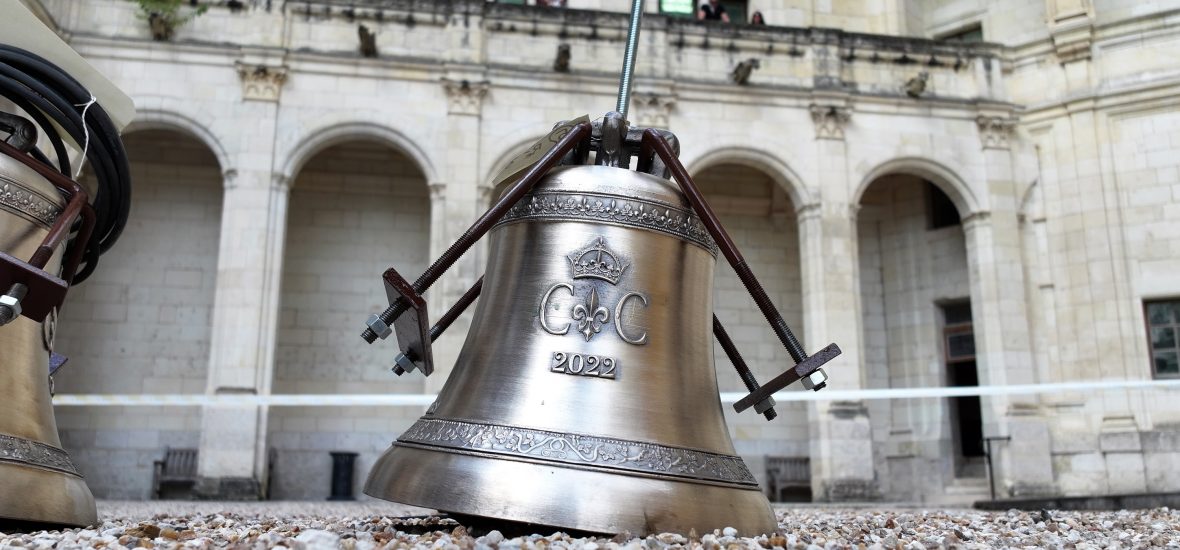

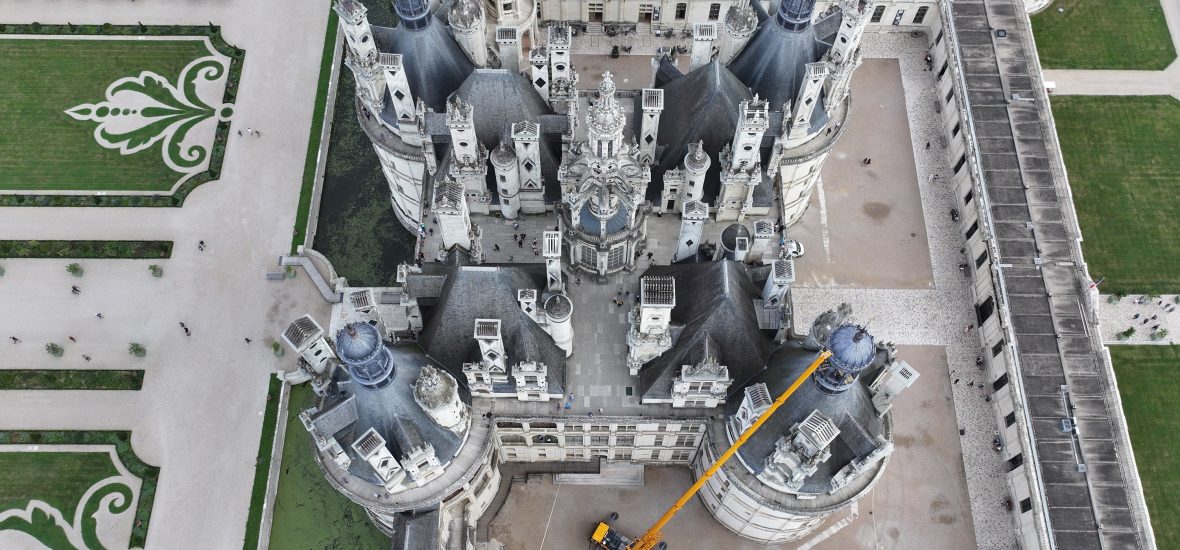
Recovery credits made it possible to launch the project to restore the six turrets, avoiding the need to stagger the restoration over five years whilst helping to bolster the heritage sector by conducting a project of extraordinary scope and quality.
The project was originally supposed to begin with several phases in 2020, at a pace of one or two lanterns per year. The first COVID shutdown brought all work on the Château to a halt for nearly a year. The historic monuments credits and unspecified credits granted to Domaine National de Chambord by Roselyne Bachelot, French Minister of Culture, in the name of support under the recovery plan, enabled the resumption of the entirety of the rest of the project. This pooling of funds made it possible to offer heritage firms and craftspeople the chance to work on a stable project involving a wide array of trades, after they had suffered severe financial repercussions due to the various COVID shutdowns. For some tradesmen (like ornamentalists and gilders), it is a rare opportunity to gain access to an operation that provides so much work all at once.

